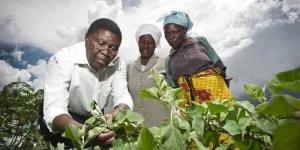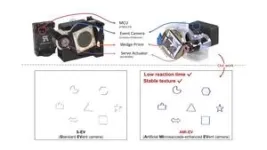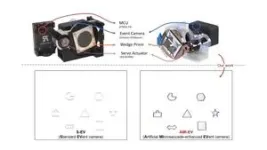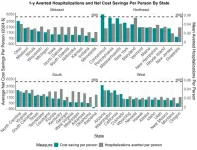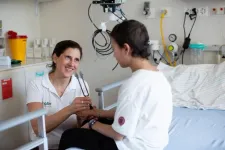(Press-News.org) The most climate-vulnerable countries with the highest hunger rates are significantly under-represented in agrifood research – sparking a need for urgent action and increased investments to redress this imbalance, a major new study has found.
The ‘State of the Field for Research on Agrifood Systems’ report, published by The Juno Evidence Alliance – a partnership of CABI, Havos.Ai and the University of Notre Dame, USA – found that only one out of eight research papers is led by scientists from the 81 poorest countries.
The world-leading authors, which included those from the Food and Agriculture Organization of the United Nations (FAO), the International Food Policy Research Institute (IFPRI) and the Inter-American Institute for Cooperation on Agriculture (IICA), revealed that some countries have an evidence base of fewer than 1,000 articles.
Poised to shape future research agendas for greater food security
This ground-breaking report, which used artificial intelligence to assess 6.3 million scientific titles, abstracts, and metadata spanning the years 2010 to 2023, sourced from CAB Abstracts, offers an overview of current outcomes from research and is poised to shape future research agendas for greater food security with donors and governments.
It also presents a series of recommendations including calls for increased funding to support original research efforts in the world’s poorest countries – focusing on regions most vulnerable to climate change and hunger.
Furthermore, the scientists suggest greater promotion of participatory practices to incorporate women’s perspectives into agricultural research methodologies and strengthen engagement on outcome and intervention pathways to foster coherence and cooperation in addressing agricultural challenges.
Inclusive and equitable development within food systems
Professor Jaron Porciello, Director of the Juno Evidence Alliance and lead author of ‘The State of the Field for Research on Agrifood Systems,’ said, “This report aligns scientific research with policy imperatives, concentrating on outcomes and interventions proposed by scientists to guide inclusive and equitable development within food systems across low-and middle-income countries.”
The report highlights how research publication in agriculture and food systems have increased more than 60% in the past decade, with publications spanning over 35,000 journals and technical reports within agricultural domains alone.
However, dominance in agricultural research publications by countries such as China, the USA, Brazil and India, the scientists say, underscores the need for enhanced focus on regions with disproportionately lower research output.
Insights crucial for informed policymaking
They add that under-representation of scientists from the world’s poorest countries in scientific publications stifles global conversation, impeding the acquisition of contextually relevant insights crucial for informed policymaking.
Professor Porciello added, “Discrepancies in crop-related research, where cereals receive 40% more research attention than fruits and vegetables, highlights potentially missed opportunities to address critical outcomes through interventions – particularly in promoting gender equity, nutritional outcomes, and sustainable farming practices.”
“Keeping pace presents an immense challenge. Beyond the sheer volume lies the Herculean task of synthesizing scientific research into actionable evidence.”
Further recommendations from ‘The State of the Field for Research on Agrifood Systems’ report include calls for greater investment in initiatives promoting crop diversification to enhance food security and agricultural sustainability.
The report also highlights the need for high-quality research aimed at bridging the gap between farmers’ perceptions of climate change and actionable advisory services.
Other researchers who collaborated on the research included those from Cornell University and the University of Texas, USA, the University of Helsinki, Finland, and Global Affairs Canada.
Additional information
Main image: Credit: CABI.
Media enquiries
Professor Jaron Porciello, Global Director, Evidence and Policy, CABI and Chief Technology Officer of Havos.Ai, and Lead author of The State of the Field for Research on Agrifood Systems, email: j.porciello@cabi.org
Wayne Coles, Senior PR Manager, CABI, email: w.coles@cabi.org
Full report reference
Porciello, J., et al (2024). The State of the Field for Research on Agrifood Systems. Juno Reports. https://doi.org/10.1079/junoreports.2024.0001
The report can be read here.
Acknowledgements
The report was funded by UK International Development and the Bill & Melinda Gates Foundation.
About the Juno Evidence Alliance
The Juno Evidence Alliance is co-founded by CABI, the University of Notre Dame, and Havos.Ai, with support from the Foreign, Commonwealth & Development Office (FCDO) in the United Kingdom, the Bill & Melinda Gates Foundation, the Rockefeller Foundation, and the US Agency for International Development.
Juno is a pioneering global platform at the forefront of transforming agriculture, food systems, and climate adaptation through evidence-based policy. Our mission is to fill the critical gap in the coordination and standardization of evidence-informed decision-making processes.
By harnessing the power of artificial intelligence and established scientific research methods, we expedite the synthesis of diverse data sources, delivering scientific and technical conclusions for governments, funders, and policymakers worldwide.
Juno brings together researchers, policymakers, publishers, computer and data scientists, and evidence advocates from across fields and disciplines to break down traditional boundaries between research production and use.
For more information visit: https://www.junoevidencealliance.org
END
Most climate-vulnerable countries with highest hunger rates significantly under-represented in agrifood research
The most climate-vulnerable countries with the highest hunger rates are significantly under-represented in agrifood research – sparking a need for urgent action and increased investments to redress this imbalance, a major new study has found
2024-07-01
ELSE PRESS RELEASES FROM THIS DATE:
UMD researchers develop new and improved camera inspired by the human eye
2024-07-01
A team led by University of Maryland computer scientists invented a camera mechanism that improves how robots see and react to the world around them. Inspired by how the human eye works, their innovative camera system mimics the tiny involuntary movements used by the eye to maintain clear and stable vision over time. The team’s prototyping and testing of the camera—called the Artificial Microsaccade-Enhanced Event Camera (AMI-EV)—was detailed in a paper published in the journal Science Robotics in May 2024.
“Event cameras are a relatively new technology better at tracking ...
Self-assembling, highly conductive sensors could improve wearable devices
2024-07-01
UNIVERSITY PARK, Pa. — To advance soft robotics, skin-integrated electronics and biomedical devices, researchers at Penn State have developed a 3D-printed material that is soft and stretchable — traits needed for matching the properties of tissues and organs — and that self-assembles. Their approach employs a process that eliminates many drawbacks of previous fabrication methods, such as less conductivity or device failure, the team said.
They published their results in Advanced Materials.
“People have been developing soft and stretchable conductors for almost a decade, but the conductivity ...
Lab values predict periprosthetic joint infection in patients with morbid obesity
2024-07-01
Waltham — July 1, 2024 — For patients with severe obesity undergoing knee or hip replacement, commonly obtained laboratory values – including markers of anemia and inflammation – are independent predictors of the risk of periprosthetic joint infection (PJI), reports a study in The Journal of Bone & Joint Surgery. The journal is published in the Lippincott portfolio by Wolters Kluwer.
Hemoglobin level, platelet count, and several markers of systemic inflammation may be relevant to the elevated ...
Study suggests states could cut healthcare costs by delivering patient tailored meals
2024-07-01
Chicago (July 1, 2024) — According to new research looking at every U.S. state, programs that deliver medically tailored meals (MTMs) to people with diet-sensitive conditions such as diabetes and heart disease along with limitations in the ability to perform daily activities could lead to substantial savings in healthcare costs. Using computer models to estimate the benefits of such programs minus the expense of implementing them, researchers found significant variation between U.S. states but an overall net cost savings in almost every state.
“By ...
Novel spectroscopy technique sheds light on NOx reduction
2024-07-01
When power plants burn fossil fuels at high temperatures, nitrogen and oxygen molecules break apart and then recombine to form a class of compounds called nitrogen oxides, or NOx. These gasses are major pollutants and contribute to—among other things—acid rain and global warming.
One way to curb such emissions is with a catalytic converter, similar to what’s used in a vehicle.
“The catalytic converter injects ammonia into the plant’s emissions stream, and the hydrogen in the ammonia reacts with the oxygen in the NOx, and the products ...
Fluorine-18 prostate-specific membrane antigen–1007 PET/CT vs multiparametric MRI for locoregional staging of prostate cancer
2024-07-01
About The Study: In this phase 2 prospective validating paired cohort study, fluorine-18 PSMA-1007 PET/computed tomography was superior to magnetic resonance imaging (MRI) for the locoregional staging of prostate cancer. These findings support PSMA PET in the preoperative workflow of intermediate-risk and high-risk tumors.
Corresponding Author: To contact the corresponding author, Adam Kinnaird, M.D., Ph.D., email ask@ualberta.ca.
To access the embargoed study: Visit our For The Media website at ...
Xue to receive funding for project aimed at youth tobacco use prevention
2024-07-01
Hong Xue, Associate Professor, Health Administration and Policy, received funding for the project: “Innovating and Implementing Youth Tobacco Prevention in Virginia.”
Xue will leverage the forefront of technological innovation, utilizing generative artificial intelligence (AI) and state-of-the-art immersive technologies, integrating them with novel just-in-time adaptive intervention strategies, to tackle the pressing public health issue of electronic cigarette/tobacco use among the youth in Virginia.
Xue will receive $450,000 from Virginia ...
Petricoin conducting protein pathway activation based signaling mapping of head and neck cancers
2024-07-01
Emanuel Petricoin, Co-Director, Center for Applied Proteomics and Molecular Medicine (CAPMM), received funding for the project: “Protein Pathway Activation Based Signaling Mapping of Head And Neck Cancers.”
CAPMM researchers will receive laser microdissected tumor samples from banked Formalin-Fixed Paraffin-Embedded (FFPE) clinical biopsy samples from patients with HPV‐positive head and neck cancers who were treated for newly diagnosed disease.
The researchers will utilize comprehensive reverse‐phase ...
Marasco studying inclusive design of contactless fingerprints to mitigate skin tone and gender bias
2024-07-01
Emanuela Marasco, Assistant Professor, Center for Secure Information Systems, received funding for the project: “Identity Verification in Smartphones as Social Intersectionality: Inclusive Design of Contactless Fingerprints to Mitigate Skin Tone and Gender Bias.”
She is developing a contactless biometric mobile security application that can mitigate the vulnerabilities of deep artificial intelligence and optical sensors and allow marginalized identities the same access to data security.
As part of their work, members of the project team will identify the impact of physical vulnerabilities; their ...
Physical exercise prevents nerve damage during chemotherapy
2024-07-01
Cancer treatments often cause nerve damage that can lead to long-lasting symptoms. Medication has proven ineffective in these cases. A sports scientist at the University of Basel, together with an interdisciplinary team from Germany, has now shown that simple exercises can prevent nerve damage.
Cancer therapies have improved over the years. It is no longer just about sheer survival: quality of life after recovery is gaining more importance.
Unfortunately, many cancer medications, from chemotherapy to modern immunotherapies, attack the nerves as well as the tumor cells. Some therapies, such as oxaliplatin or vinca alkaloids, leave 70 to 90 percent of patients complaining of pain, balance ...
LAST 30 PRESS RELEASES:
Smartphone-based interventions show promise for reducing alcohol and cannabis use: New research
How do health care professionals determine eligibility for MAiD?
Microplastics detected in rural woodland
JULAC and Taylor & Francis sign open access agreement to boost the impact of Hong Kong research
Protecting older male athletes’ heart health
KAIST proposes AI-driven strategy to solve long-standing mystery of gene function
Eye for trouble: Automated counting for chromosome issues under the microscope
The vast majority of US rivers lack any protections from human activities, new research finds
Ultrasound-responsive in situ antigen "nanocatchers" open a new paradigm for personalized tumor immunotherapy
Environmental “superbugs” in our rivers and soils: new one health review warns of growing antimicrobial resistance crisis
Triple threat in greenhouse farming: how heavy metals, microplastics, and antibiotic resistance genes unite to challenge sustainable food production
Earthworms turn manure into a powerful tool against antibiotic resistance
AI turns water into an early warning network for hidden biological pollutants
Hidden hotspots on “green” plastics: biodegradable and conventional plastics shape very different antibiotic resistance risks in river microbiomes
Engineered biochar enzyme system clears toxic phenolic acids and restores pepper seed germination in continuous cropping soils
Retail therapy fail? Online shopping linked to stress, says study
How well-meaning allies can increase stress for marginalized people
Commercially viable biomanufacturing: designer yeast turns sugar into lucrative chemical 3-HP
Control valve discovered in gut’s plumbing system
George Mason University leads phase 2 clinical trial for pill to help maintain weight loss after GLP-1s
Hop to it: research from Shedd Aquarium tracks conch movement to set new conservation guidance
Weight loss drugs and bariatric surgery improve the body’s fat ‘balance:’ study
The Age of Fishes began with mass death
TB harnesses part of immune defense system to cause infection
Important new source of oxidation in the atmosphere found
A tug-of-war explains a decades-old question about how bacteria swim
Strengthened immune defense against cancer
Engineering the development of the pancreas
The Journal of Nuclear Medicine ahead-of-print tip sheet: Jan. 9, 2026
Mount Sinai researchers help create largest immune cell atlas of bone marrow in multiple myeloma patients
[Press-News.org] Most climate-vulnerable countries with highest hunger rates significantly under-represented in agrifood researchThe most climate-vulnerable countries with the highest hunger rates are significantly under-represented in agrifood research – sparking a need for urgent action and increased investments to redress this imbalance, a major new study has found
